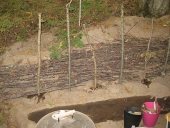Distance of Contour Lines
Try to locate as many contour lines as possible. Remember, the closer the contour lines to each other, the more potential erosion control occurs. Also, more nutrient rich biomass is produced and made available to the crops growing in the alley.
Criteria
There are two criteria for determining the distance between contour lines: vertical drop and surface distance. Generally, no more than a one meter vertical drop is desirable for effective erosion control. Therefore, the steeper the slope, the closer the contour hedgerows. Conversely, the flatter the slope, the wider the spacing of hedges. However on the flatter slopes, it is recommended that contour hedgerows be spaced no further apart than 5 meters in order to maximize the benefits of the nitrogen fixing trees/shrubs on soil fertility management.
In determining a one meter vertical drop, the "eye-hand" method is a simple procedure to use. If using a transit or home-made transit, the 1 meter vertical drop can be obtained very quickly.
Step 3: PREPARE THE CONTOUR LINES
After you have found and marked the contour lines, prepare them by plowing and harrowing until ready for planting. The width of each area to be prepared should be one meter. The stakes will serve as your guide during plowing.
Step 4: PLANT SEEDS OF NITROGEN FIXING TREES AND SHRUBS
Planting Nitrogen Fixing Species
On each prepared contour line make two (2) furrows at a distance of one-half meter apart. Sow the seeds in each furrow to allow for a good, thick stand of seedling. Cover the seeds lightly and firmly with soil.
Importance of Leguminous Hedgerows
The ability of nitrogen fixing trees to grow on poor soils and in areas with long dry seasons makes them good plants for restoring forest cover to watersheds, slopes and other lands that have been denuded of trees. Through natural leaf drop they enrich and fertilize the soil. In addition, they compete vigorously with coarse grasses, a common feature of many degraded areas that have been deforested or depleted by excessive agriculture.
Examples of Nitrogen Fixing Trees and Shrubs (NFTS)
Flemingia macrophylla, Desmodium rensonii, Gliricidia sepium, and Calliandra calothyrsus are the best examples of nitrogen fixing trees for hedgerows on the SALT farm. Other examples of nitrogen fixing trees and shrubs (NFTS) which may be suitable for SALT hedgerows are Indigofera tyesmane, Calliandra tetragona, Leucaena luecocephala, and Leucaena diversifolia. The members of the Cassia genus such as spectabilis and siamea are not mentioned here because of their doubtful fixing on nitrogen. Remember, you must select the species that grows best in your climate and particular soils.
Step 5: CULTIVATE ALTERNATE STRIPS
The space of land between the thick rows of nitrogen fixing trees where the crops are planted is called a strip. Others names for the strip are alleyways or avenues.
Cultivating Alternate Strips
If you wish to prepare the soil for planting before the NFTS are fully grown, do it alternately, on strips 2, 4, 6, 8 and so on. Alternate cultivation will prevent erosion because the unplowed strips will hold the soil in place. When the NFTS are fully grown, you can proceed with cultivation on every strip.
Step 6: PLANT PERMANENT CROPS
Plant permanent crops in every third strips. They may be planted at the same time the seeds of nitrogen fixing trees are sown. Only the spots for planting are cleared and dug; later, only ring weeding is employed until the NFTS are large enough to hold the soil so full cultivation can begin.
Examples of Permanent Crops
Durian, lanzones, rambutan, coffee, banana, citrus, cacao, and others of the same height are good examples of permanent crops. Tall crops are planted at the bottom of the hill while the short ones are planted at the top. Shade-tolerant permanent crops can be intercropped with the tall crops.
Step 7: PLANT SHORT-AND-MEDIUM TERM CROPS
You can plant short and medium-term income producing crops between stripc of and among permanent crops. They are your sources of food and regular income while waiting for the permanent crops to bear fruits.
Examples of Short-term Crops
Suggested short and medium-term crops are pineapple, ginger, gabi, castor bean, camote, peanut, mung bean, sorghum, corn, upland rice, etc. To avoid shading, short plants are planted away from tall ones.
Step 8: TRIM REGULARLY NITROGEN FIXING TREES/SHRUBS
Pruning Hedgerows
About once a month, the continuously NFTS are cut down to a height of one to one half meters from the ground. Cut leaves and twigs are always piled at the base of the crops. They serve as a soil cover to minmize the impact of the raindrop on the bare soil. They also act as an excellent organic fertilizer for both the permanent and short-term crops. In this way only, a minimal amount of commercial fertilizer (about 1/4 of the total fertilizer requirements) is necessary.
Step 9: PRACTICE CROP ROTATION
Rotating Non-Permanent Crops
A good way of rotating is to plant grains (corn, upland rice, sorghum, etc.), tubers (camote, cassava, gabi, etc.) andothe rcrops (pineapple, casto bean, etc.) on strips where legumes (mung bean, bush sitao, peanut, etc.) were planted previously and vice versa. This practice will help maintain the fertility and good condition of your soil. Other management practices in crop growing like weeding and pest and insect control should done regularly.
Step 10: BUILD GREEN TERRACES
Maintain Green Terraces
Apart from providing you with adequate food and sufficient income, another even more important benefit of using SALT is the control of soil erosion. This is done by the double thick rows of nitrogen fixing trees and ht natural terraces being formed along the contour lines. As you go on farming the sloping land, keep gathering and piliing up straw, stalks, twigs, branches, leaves, rocks, and stones at he base ofhte rows of nitrogen fixing trees. By doing this regualrly and as the years go by, you can build strong,sustainable, naturally green and beautiful terraces which will reliable anchor your precious soil in its right place.
Advantages of SALT Farming
As a proven system of upland farming, SALT has certain good qualities over both the tradtional techniques of slash-and-burn and conventional terrace farming.
The SALT system protects the soil from erosion.
SALT helps restore soil fertility and structure.
SALT is efficeint in food crop production.
SLAT is applicable to at least 50 per cent of hillside farms.
SALT can be duplicated readily by hillside farmers.
SALT is culturally acceptable becaused the farming production as the top priority. Fruit trees, forest and other crops are secondary priority.
SALT is workable in a relatively short time.
SALT is economically feasible.
SALT is ecologically sound.
The SALT farm can easily revert back to forest land if left unfarmed.
In the Philippines SALT fits into the framework of the government's rainfed resoiurces development strategy for the uplands.
Conclusion
The Asian Rural Life Development Foundation recognizes that SALT is not a perfect farming system. There is not and never will be one system for all farmers. SALT is not a miracle nor a panacea. To establish a one-hectare SALT farm requires much hard work and discipline. There is no easy way. It takes three to ten years to deplete the soil of nutrients and to lose the topsoil; no system can bring depleted, eroded soil back into production in a few short years. Soil loss leads to low yields and poverty, but land can be restored to a reasonable level of productivity by using SALT.
Do you have any questions or suggestions? Let us know. See us personally at the Asian Rural Life Development Foundation located on the campus of the Mindanao Baptist Rural Life Center in Kinuskusan, Bansalan, Davao del Sur or write to us at P.O. Box 80322, 8000 Davao City. You can also send us an email; our address is:
2081351@mcimail.com. We will be happy to recieve your comments.
Some Fact and Figures on the Original SALT Farm
Source: Asian Rural Life Development Foundation Editorial Staff, 1997. How to Series (1), Kinuskusan, Bansalan, Davao del Sur, 20p.


























 2
2













